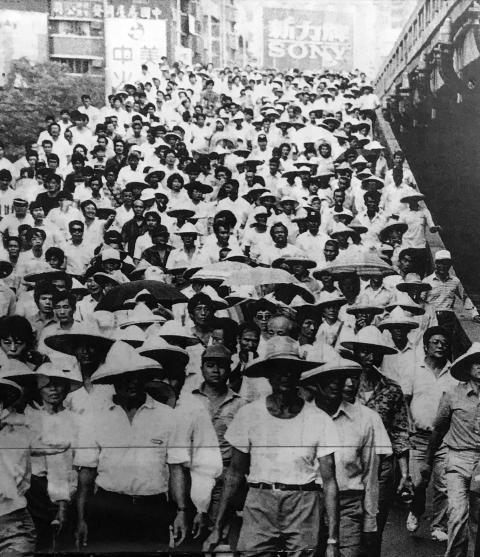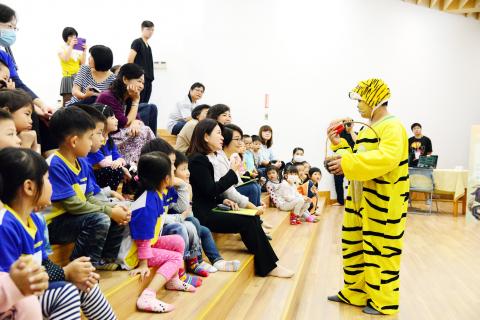May 22 to May 28
Chien Chi (簡吉), the “professional peasant revolutionary” featured in last week’s column, was not meant to live a complacent life. In 1947, he was in trouble again for organizing a resistance army to fight Chinese Nationalist Party (KMT) troops during the suppression of the 228 Incident. He went into hiding and worked as a Chinese Communist Party agent until he was caught and executed in 1951.
There would only be a handful of minor and regional farmer protests over the following several decades under the KMT’s reign of White Terror, where dissidents like Chien faced dire consequences. Early land reforms largely eliminated the landowner system, which boosted production but also allowed the state to directly control the farmers. Wu Yen-chang writes in The Formation and Development of Taiwan’s Farmers’ Movement (台灣農民運動的形成與發展) that farmers were organized under state-funded farmers associations, which “operated according to the benefit of the country instead of the agriculture industry and individual farmers.”

Photo: Huang Shu-li, Taipei Times
DISCONTENT BOILS OVER
Martial law would not be lifted until 1987, but as state control loosened, various social movements took shape in the early 1980s, championing issues ranging from pollution to women’s rights to student government elections. Wu writes that these activities encouraged the farmers to speak out as well. He adds that non-KMT politicians, such as Chu Kao-cheng (朱高正), often sought to broaden their voting base by taking up farmers’ issues.
Taiwan’s farmers were hit hard by natural disasters in 1986, which Wu writes was the worst in more than two decades. To make matters worse, farmers began noticing that their fruit prices were plummeting. In an interview with Reading Taiwan magazine, (重現台灣史) opposition politician Lin Feng-hsi (林豐喜) says that nobody could figure out why until they saw that fruit stands were selling mostly imported fruit.

Photo: Lin Kuo-hsien, Taipei Times
Under Lin’s lead, more than 3,000 farmers gathered in front of the Legislative Yuan on Dec. 8, 1987 to protest the increase in imports. The government put together a task force and met with the farmers, where they presented their requests. Five months later, about 500 people rode their farming vehicles on the streets of Taipei during trade talks between the US and Taiwan, protesting the proposed importing of turkey meat. Lin put together a call for farmers insurance as well.
DRAWING BLOOD
Lin says that he was against taking to the streets so on May 20, 1988, but other activists went ahead with the plan. Spearheaded by the Yunlin Farmers Association (雲林農權會) and future legislators Lin Kuo-hua (林國華) and Hsiao Yu-chen (蕭裕珍), thousands of farmers from across the country met in front of Taipei’s Sun Yat-sen Memorial Hall in the morning. Their demands included universal insurance for farmers, reduced taxes on fertilizer, free trade of farmland and reform to farmers associations.
According to a Reading Taiwan article on the event, trouble started when the marchers reached the Legislative Yuan. Some protesters attempted to enter the building to use the restroom but were turned away by the police. Tensions rose and people started throwing cans and rocks at the authorities, who responded by arresting three protesters. Lin Kuo-hua charged the building in a rescue attempt, and was knocked unconscious and sent to the hospital. The situation worsened, and the Legislative Yuan’s sign was torn down before the angry protesters turned their attention to other government agencies. Clashes continued throughout the day as riot police arrived with barricades and water trucks, while protesters smashed the National Police Agency sign and burned cars. Gas bombs were also thrown.
Lin Kuo-hua and Hsiao were arrested around 7pm. By this time, many farmers had left, but the ranks were bolstered by angry civilians and peaceful students. The chaos continued into the night as riot police lost patience and charged the protesters, who responded with more violence and destruction. Things did not calm down until the morning. It was the most severe incident between civilians and authorities since the 228 Incident.
More than 100 people were hospitalized and 92 faced criminal charges. There was much debate on whether the violence was premeditated, as the police claimed to have found a whole truckload of rocks hidden under vegetables. Only 13 people were acquitted while Lin, Hsiao and other organizers received the heaviest sentences of nearly three years.
AFTERMATH
An investigation into the incident by Academia Sinica scholar Hsu Mu-chu (許木柱) concluded that the protesters did attack first, but also denounced the riot police for exacerbating the situation. Hsu also declared that the violence was not premeditated but a result of emotions running high on both sides.
The two Lins have conflicting opinions on the effects of this incident, both recorded in Reading Taiwan.
“If the 520 Incident hadn’t happened, there were many other farmer issues I had planned to tackle. But I noticed that most farmers became reluctant to protest. The momentum we gained after our Dec. 8 efforts was completely erased. The large-scale peasant movement that rose again after 60 years of silence was abruptly aborted,” says Lin Feng-hsi.
“I believe that the 520 incident helped the farmers greatly,” Lin Kuo-hua says. “The government started taking farmer’s rights seriously and sped up its policy reform. Our demands were eventually met, and I believe that farmers will agree with me that 520 yielded positive results.”
Taiwan in Time, a column about Taiwan’s history that is published every Sunday, spotlights important or interesting events around the nation that have anniversaries this week.

Most heroes are remembered for the battles they fought. Taiwan’s Black Bat Squadron is remembered for flying into Chinese airspace 838 times between 1953 and 1967, and for the 148 men whose sacrifice bought the intelligence that kept Taiwan secure. Two-thirds of the squadron died carrying out missions most people wouldn’t learn about for another 40 years. The squadron lost 15 aircraft and 148 crew members over those 14 years, making it the deadliest unit in Taiwan’s military history by casualty rate. They flew at night, often at low altitudes, straight into some of the most heavily defended airspace in Asia.

This month the government ordered a one-year block of Xiaohongshu (小紅書) or Rednote, a Chinese social media platform with more than 3 million users in Taiwan. The government pointed to widespread fraud activity on the platform, along with cybersecurity failures. Officials said that they had reached out to the company and asked it to change. However, they received no response. The pro-China parties, the Chinese Nationalist Party (KMT) and Taiwan People’s Party (TPP), immediately swung into action, denouncing the ban as an attack on free speech. This “free speech” claim was then echoed by the People’s Republic of China (PRC),

Many people in Taiwan first learned about universal basic income (UBI) — the idea that the government should provide regular, no-strings-attached payments to each citizen — in 2019. While seeking the Democratic nomination for the 2020 US presidential election, Andrew Yang, a politician of Taiwanese descent, said that, if elected, he’d institute a UBI of US$1,000 per month to “get the economic boot off of people’s throats, allowing them to lift their heads up, breathe, and get excited for the future.” His campaign petered out, but the concept of UBI hasn’t gone away. Throughout the industrialized world, there are fears that

Like much in the world today, theater has experienced major disruptions over the six years since COVID-19. The pandemic, the war in Ukraine and social media have created a new normal of geopolitical and information uncertainty, and the performing arts are not immune to these effects. “Ten years ago people wanted to come to the theater to engage with important issues, but now the Internet allows them to engage with those issues powerfully and immediately,” said Faith Tan, programming director of the Esplanade in Singapore, speaking last week in Japan. “One reaction to unpredictability has been a renewed emphasis on